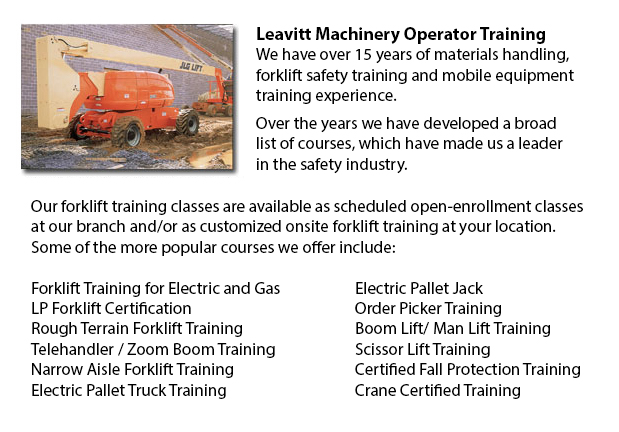
St Catharines Aerial Boom Lift Ticket - Aerial forklifts can accommodate many tasks involving high and tough reaching spaces. Often used to perform daily repair in buildings with lofty ceilings, trim tree branches, raise burdensome shelving units or fix telephone lines. A ladder could also be utilized for some of the aforementioned jobs, although aerial lifts offer more safety and strength when properly used.
There are many versions of aerial lifts existing on the market depending on what the task needed involves. Painters often use scissor aerial hoists for example, which are grouped as mobile scaffolding, handy in painting trim and reaching the 2nd story and higher on buildings. The scissor aerial lifts use criss-cross braces to stretch out and enlarge upwards. There is a platform attached to the top of the braces that rises simultaneously as the criss-cross braces lift.
Cherry pickers and bucket trucks are another kind of the aerial lift. Typically, they contain a bucket at the end of an extended arm and as the arm unfolds, the attached bucket platform rises. Forklifts utilize a pronged arm that rises upwards as the handle is moved. Boom hoists have a hydraulic arm that extends outward and elevates the platform. Every one of these aerial lift trucks require special training to operate.
Training courses presented through Occupational Safety & Health Association, known also as OSHA, cover safety methods, system operation, maintenance and inspection and device cargo capacities. Successful completion of these education programs earns a special certified license. Only properly certified individuals who have OSHA operating licenses should run aerial platform lifts. The Occupational Safety & Health Organization has developed rules to maintain safety and prevent injury while utilizing aerial hoists. Common sense rules such as not utilizing this machine to give rides and ensuring all tires on aerial hoists are braced in order to hinder machine tipping are mentioned within the guidelines.
Unfortunately, figures reveal that in excess of 20 aerial lift operators pass away each year while operating and almost ten percent of those are commercial painters. The majority of these incidents were triggered by improper tie bracing, therefore many of these might have been prevented. Operators should ensure that all wheels are locked and braces as a critical security precaution to stop the instrument from toppling over.
Other guidelines include marking the surrounding area of the machine in a visible manner to protect passers-by and to guarantee they do not approach too close to the operating machine. It is vital to ensure that there are also 10 feet of clearance among any power cables and the aerial hoist. Operators of this equipment are also highly recommended to always have on the appropriate security harness while up in the air.
-
St Catharines Heavy Equipment Training Schools
St Catharines Heavy Equipment Training Schools - When selecting an operator training course, there are a lot of heavy equipment training schools to choose from. To be able to ascertain the qualifications you will attain, it is very important to explo... More -
St Catharines Heavy Equipment Operator Training
St Catharines Heavy Equipment Operator Training - Heavy equipment operator training facilities that offer quality standards within the business, offering field performance work and additional machine training are really sought after training features... More -
St Catharines Forklift Training Programs
St Catharines Forklift Training Programs - Are you looking for work as a driver of a forklift? Our regulatory-compliant mobile equipment operator training offers instruction in kinds of forklifts, pre-shift check, fuel kinds and handling of fuels, an... More -
St Catharines Heavy Equipment License
St Catharines Heavy Equipment License - A heavy equipment license can be obtained by taking a certification and preparation course at a private training school or a vocational school. This license would qualify you to operate various types of heavy e... More -
St Catharines Overhead Crane Safety Training
St Catharines Overhead Crane Safety Training - Overhead crane safety training equips operators with skills and knowledge regarding crane safety precautions, accident avoidance, materials handling, and equipment and stock protection. Trainees will lea... More -
St Catharines Scissor Lift Training
St Catharines Scissor Lift Training - Scissor lifts should be operated proficiently to be able to protect the safety of the equipment and the wellbeing of others within the workplace. Operators who are skilled are trained to drive the specific type o... More -
St Catharines Telescopic Training
St Catharines Telescopic Training - Telescopic Handlers are a kind of forklift, normally known as telehandlers. This machine has been increasing in popularity due to its greater lift heights and its versatility. It is often preferred over the convent... More -
St Catharines Boom Lift Certification
St Catharines Boom Lift Certification - Utilizing elevated work platforms allow for maintenance operations and work to be carried out at elevated work heights which were otherwise unreachable. Boom Lift Certification Training educates workers about t... More

Forklift Certification St Catharines
TOLL FREE: 1-888-254-6157
St Catharines, Ontario
forkliftcertificationstcatharines.com/
Email Us
About Us


